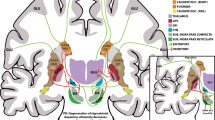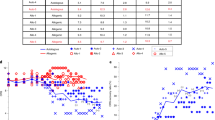Abstract
Clinical trials are under way using fetal cells to repair damaged neuronal circuitry. However, little is known about how transplanted immature neurons can grow anatomically correct connections in the adult central nervous system (CNS). We transplanted embryonic porcine neural cells in vivo into adult rat brains with neuronal and axonal loss typical of Parkinson's or Huntington's disease. Using complementary species-specific cellular markers, we found donor axons and CD44+ astroglial fibres in host white matter tracts up to 8 mm from CNS transplant sites, although only donor axons were capable of reaching correct gray matter target regions. This work demonstrates that adult host brain can orient growth of transplanted neurons and that there are differences in transplant donor glial and axonal growth patterns in cellular repair of the mature CNS.
This is a preview of subscription content, access via your institution
Access options
Subscribe to this journal
Receive 12 print issues and online access
$209.00 per year
only $17.42 per issue
Buy this article
- Purchase on Springer Link
- Instant access to full article PDF
Prices may be subject to local taxes which are calculated during checkout
Similar content being viewed by others
References
Freed, C. et al. Survival of implanted fetal dopamine cells and neurologic improvement 12 to 24 months after transplantation for Parkinson's disease. New Engl. J. Med. 327, 1549–1555 (1992).
Lindvall, O. et al. Evidence for long-term survival and function of dopaminergic grafts in progressive Parkinson's disease. Ann. Neurol. 35, 172–180 (1994).
Kordower, J.H. et al. Neuropathological evidence of graft survival and striatal reinnervation after the transplantation of fetal mesencephalic tissue in a patient with Parkinson's disease. New Engl. J. Med. 332, 1118–1124 (1995).
Galpern, W.R. et al. Xenotransplantation of fetal porcine ventral mesencephalon results in functional recovery in a rat model of Parkinson's disease. J. Neurosurg. Proc. AANS, 38 (1995).
Björklund, A., Brundin, P. & Isacson, O. Neuronal replacement by intracerebral neural implants in animal models of neurodegenerative disease. Adv. Neurol. 47, 455–492 (1988).
Keynes, R.J. & Cook, G.M.W. Repellent cues in axon guidance. Curr. Opin. Neurobiol. 2, 55–59 (1992).
Patterson, P.H. On the importance of being inhibited, or say no to growth cones. Neuron 1, 263–267 (1988).
Schwab, M.E. & Caroni, P. Oligodendrocytes and CNS myelin are nonpermissive substrates for neurite growth and fibroblast spreading in vitro. J. Neurosci. 8, 2381–2393 (1988).
Wictorin, K., Brundin, P., Gustavii, B., Lindvall, O. & Björklund, A. Reformation of long axon pathways in adult rat central nervous system by human forebrain neuroblasts. Nature 347, 556–558 (1990).
Wictorin, K., Brundin, P., Sauer, H., Lindvall, O. & Björklund, A. Long distance directed axonal growth from human dopaminergic mesencephalic neuroblasts implanted along the nigrostriatal pathway in 6-hydroxydopamine lesioned adult rats. J. comp. Neurol. 323, 475–494 (1992).
Davies, S.J.A., Field, P.M. & Raisman, G. Long fibre growth by axons of embryonic mouse hippocampal neurons microtransplanted into the adult rat fimbria. Eur. J. Neurosci. 5, 95–106 (1993).
Davies, S.J.A., Field, P.M. & Raisman, G. Long interfascicular axon growth from embryonic neurons transplanted into adult myelinated tracts. J. Neurosci. 14, 1596–1612 (1994).
Pakzaban, P., Deacon, T.W., Burns, L.H. & Isacson, O. Increased proportion of acetylcholinesterase-rich zones and improved morphological integration in host striatum of fetal grafts derived from the lateral but not the medial ganglionic eminence. Exp. Brain Res. 97, 13–22 (1993).
Deacon, T.W., Pakzaban, P. & Isacson, O. The lateral ganglionic eminence is the source of striatal phenotypes: Neural transplantation and developmental evidence. Brain Res. 668, 211–219 (1994).
Deacon, T.W., Pakzaban, P., Burns, L.H., Dinsmore, J. & Isacson, O. Cytoarchitectonic development and axon-glia relationships in homotopic porcine striatal xenografts in rats. Exp. Neurol. 130, 151–167 (1994).
Aguayo, A.J., Björklund, A., Stenevi, U. & Carlstedt, T. Fetal mesencephalic neurons survive and extend long axons across PNS grafts inserted into the adult striatum. Neurosci. Lett. 45, 53–58 (1984).
Brundin, P., Isacson, O. & Björklund, A. Monitoring of cell viability of embryonic CNS tissue as a criterion for intracerebral graft survival. Brain Res. 331, 251–259 (1985).
Zhou, H. & Lund, R.D. Effects of the age of donor or host tissue on astrocyte migration from intracerebral xenografts of corpus callosum. Exp. Neurol. 122, 155–164 (1993).
Snow, M.H.L. & Tarn, P.P.L. Timing in embryological development. Nature 286, 107 (1980).
Sacher, G.A. & Staffeldt, E.F. Relation of gestation time to brain weight in placental mammals. Am. Natur. 108, 593–616 (1974).
Dickerson, J.W.T. & Dobbing, J. Prenatal and postnatal growth and development of the central nervous system of the pig. Proc. R. Sac. Br. 166, 384–395 (1967).
Forssman, J., Thesis. Lund Univ. (Gustav Fischer Verlag, Jena, 1898).
Hamburger, V. The development and innervation of transplanted limb primordia of chick embryos. J. exp. Zool. 80, 147–189 (1939).
Sperry, R.W. Chemoaffinity in the orderly growth of nerve fiber patterns and connections. Proc. natn. Acaa. Sci. U.S.A. 50, 703–710 (1963).
Goodman, C.S. & Shatz, C.J. Developmental mechanisms that generate precise patterns of neuronal connectivity. Cell 10, 77–98 (1993).
Bastiani, M.J., Harrelson, A.L., Snow, P.M. & Goodman, C.S. Expression of fasciclin 1 and II glycoproteins on subsets of axon pathways during neuronal development in the grasshopper. Cell 48, 745–755 (1987).
Dodd, J., Morton, S.B., Karagogeos, D., Yamamoto, M. & Jessell, T.M. Spatial regulation of axonal glycoprotein expression on subsets of embryonic spinal neurons. Neuron 1, 105–116 (1988).
Moretto, G., Xu, R.Y. & Kim, S.U. CD44 expression in human astrocytes and Oligodendrocytes in culture. J. Neuropath. exp. Neural. 52, 419–423 (1993).
Kennedy, T.E., Seraflni, T., de la Torre, J.R. & Tessier-Lavigne, M. Netrins are diffusible chemotropic factors for commissural axons in the embryonic spinal cord. Cell 78, 425–435 (1994).
Serafini, T. et al. The netrins define a family of axon outgrowth-promoting proteins homologous to C. elegans UNC-6. Cell 78, 409–424 (1994).
Matthes, D.J., Sink, H., Kolodkin, A.L. & Goodman, C.S. Semaphorin II can function as a selective inhibitor of specific synaptic arborizations. Cell 81, 631–639 (1995).
Colamarino, S.A. & Tessier-Lavigne, M. The axonal chemoattractant netrin-1 is also a chemorepellent for trochlear motor axons. Cell 81, 621–629 (1995).
Burden-Gulley, S.M., Payne, H.R. & Lemmon, V. Growth cones are actively influenced by substrate-bound adhesion molecules. J. Neurosci 15, 4370–4381 (1995).
Coon, H.G., Curcio, F., Sakaguchi, K., Brandi, M.L. & Swerdlow, R.D. Cell cultures of neuroblasts from rat olfactory epithelium that show odorant responses. Proc. natn. Acad. Sci. U.S.A. 86, 1703–1707 (1989).
Asher, R. & Bignami, A. Hyaluronate binding and CD44 expression in human glioblastoma cells and astrocytes. Exp. Cell Res. 203, 80–90 (1992).
Girgrah, N. et al. Localization of the CD44 glycoprotein to fibrous astrocytes in normal white matter and to reactive astrocytes in active lesions in multiple sclerosis. J. Neuropath. exp. Neural. 50, 779–792 (1991).
Girgrah, N., Ackerley, C.A. & Moscarello, M.A. Hyaluronate binding and CD44 expression in human glioblastoma cells and astrocytes: Localization of CD44 (p80) on the external surface of a human astrocytoma cell. Exp. Cell Res. 203, 80–90 (1992).
Author information
Authors and Affiliations
Rights and permissions
About this article
Cite this article
Isacson, O., Deacon, T., Pakzaban, P. et al. Transplanted xenogeneic neural cells in neurodegenerative disease models exhibit remarkable axonal target specificity and distinct growth patterns of glial and axonal fibres. Nat Med 1, 1189–1194 (1995). https://doi.org/10.1038/nm1195-1189
Received:
Accepted:
Published:
Issue Date:
DOI: https://doi.org/10.1038/nm1195-1189
This article is cited by
-
Current understanding of the molecular mechanisms in Parkinson's disease: Targets for potential treatments
Translational Neurodegeneration (2017)
-
Cellular Therapy and Induced Neuronal Replacement for Huntington's Disease
Neurotherapeutics (2011)
-
Functions of the nigrostriatal dopaminergic synapse and the use of neurotransplantation in Parkinson’s disease
Journal of Neurology (2011)
-
Brain-derived neurotrophic factor in neurodegenerative diseases
Nature Reviews Neurology (2009)
-
Setback for Huntington's disease therapy
Nature (2009)



